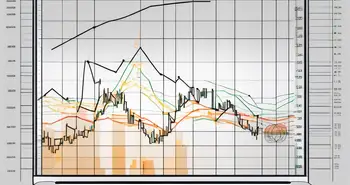Article Contents
The Impact of Bitcoin Stock to Flow Model on Market Trends

As a financial expert, I've witnessed the growing influence of the Bitcoin Stock to Flow (S2F) model on market trends. This innovative model has sparked intense debate and analysis within the cryptocurrency community. In this article, we will delve into the intricacies of the Bitcoin S2F model and explore its impact on market trends.
Understanding the Bitcoin Stock to Flow Model
Before we dive into the impact, it is crucial to understand the basics of the Bitcoin Stock to Flow model. The S2F ratio is a measure that quantifies the scarcity of an asset by comparing its stock (existing supply) to its flow (newly produced units).
The Basics of Stock to Flow
The concept of stock to flow originated from commodities, where it was primarily used to evaluate precious metals like gold and silver. This ratio provides insights into an asset's potential investment value and its scarcity relative to its production rate.
In the case of Bitcoin, the S2F ratio has gained significant traction due to the cryptocurrency's fixed supply. With only 21 million bitcoins set to ever exist, the scarcity factor plays a crucial role in determining its value.
Expanding on the concept of stock to flow, it's important to note that the model also takes into account the halving events in Bitcoin's mining process. Approximately every four years, the rewards miners receive for validating transactions are halved, reducing the rate at which new bitcoins are introduced into circulation. This halving mechanism further enhances Bitcoin's scarcity and contributes to the increasing S2F ratio over time.
The Significance of the Stock to Flow Ratio in Bitcoin
Investors and analysts have come to recognize the S2F ratio as a fundamental aspect of Bitcoin's market dynamics. The higher the ratio, the scarcer and potentially more valuable the asset becomes. Advocates of the S2F model argue that it provides a solid foundation for making future price predictions and assessing market trends.
Moreover, the stock to flow model has sparked debates within the financial community regarding its applicability to traditional assets. Some experts believe that the S2F ratio's success in predicting Bitcoin's price movements could potentially be extended to other commodities and even fiat currencies. This has led to further research and analysis into adapting the stock to flow concept to different asset classes, exploring its implications beyond the realm of cryptocurrency.
The Correlation Between Bitcoin Stock to Flow and Market Trends
Analyzing market trends in relation to the Bitcoin S2F model reveals interesting insights into the cryptocurrency's price movements.
Analyzing Market Trends in Relation to Stock to Flow
Historical data indicates a strong correlation between the S2F ratio and Bitcoin's price. According to the Bitcoin S2F model, each halving event – the periodic reduction of block rewards – leads to a significant increase in the S2F ratio. This reduction in supply growth, coupled with increasing demand, has historically resulted in upward price movements.
Moreover, the S2F model has garnered attention not only for its correlation with price movements but also for its potential implications on Bitcoin's scarcity value. As the S2F ratio increases post-halving, Bitcoin's scarcity relative to its demand is enhanced, potentially driving up its perceived value among investors and enthusiasts.
It is essential to mention that correlation does not imply causation, but understanding this relationship can assist in making informed investment decisions in the volatile world of cryptocurrencies.
The Role of Bitcoin's Stock to Flow in Predicting Market Movements
Enthusiasts of the S2F model rely on its predictive power to forecast future market movements. By assessing the S2F ratio in combination with other relevant factors, analysts attempt to anticipate price trends, identify potential market cycles, and identify favorable entry and exit points for investors.
Furthermore, the S2F model's predictive capabilities have sparked debates within the cryptocurrency community regarding its reliability in forecasting long-term price movements. Some argue that while the model has shown historical accuracy, external factors such as regulatory developments, technological advancements, and market sentiment can significantly impact Bitcoin's price trajectory, challenging the model's predictive efficacy in complex market conditions.
However, it is crucial to consider that market dynamics are influenced by a multitude of factors, and the S2F model should not be the sole basis for investment decisions.
The Influence of Bitcoin's Stock to Flow on Investment Decisions
As the awareness of the S2F model grows, investor behavior is also showing signs of being impacted by this approach to analysis.
How Stock to Flow Impacts Investor Behavior
Investors are increasingly incorporating the S2F model into their decision-making process. The scarcity factor, as quantified by the S2F ratio, provides insights into the potential value growth of Bitcoin over time. This long-term perspective may lead to changes in investment strategies, with investors opting for a more HODL-oriented (Hold On for Dear Life) approach by holding Bitcoin for extended periods.
The Risk and Reward of Investing Based on Stock to Flow
It is essential to mention that investing solely based on the S2F model carries its risks. Market volatility, regulatory changes, and technological advancements can all impact the cryptocurrency market. Thus, it is crucial to perform comprehensive due diligence, considering various factors, in addition to the S2F ratio when making investment decisions.
Criticisms and Limitations of the Bitcoin Stock to Flow Model
While the S2F model has gained significant popularity, it is not without its share of critics who highlight its limitations.
Debunking Common Misconceptions about Stock to Flow
One common misconception is that the S2F model provides an accurate and guaranteed price prediction. However, it is important to note that the S2F model is a tool for analysis and prediction, rather than an infallible crystal ball.
Additionally, critics argue that the S2F model oversimplifies the complex nature of the cryptocurrency market by focusing primarily on scarcity. While scarcity is undoubtedly an important factor, other variables, such as technology, adoption rate, and regulatory developments, also contribute to the overall market dynamics.
The Challenges of Relying Solely on Stock to Flow for Market Predictions
Another limitation of the S2F model is its inability to account for unforeseen events or external shocks that might significantly impact the market. The dynamic nature of cryptocurrencies demands a more comprehensive approach to analysis and prediction.
The Future of Bitcoin and the Stock to Flow Model
Looking ahead, it is fascinating to consider the potential changes in Bitcoin's S2F ratio.
Potential Changes in Bitcoin's Stock to Flow
Bitcoin's S2F ratio will continue to rise as halving events reduce the rate of new supply entering the market. This increasing scarcity could potentially drive the value of Bitcoin upward in the future. However, it is important to note that this is speculation and future outcomes remain uncertain.
The Long-Term Sustainability of the Stock to Flow Model
As cryptocurrency markets mature and evolve, the sustainability of the S2F model will undoubtedly face ongoing scrutiny. It is crucial for analysts and investors to adapt and incorporate other relevant factors to provide a more comprehensive understanding of the market dynamics.
Having witnessed the impact of the S2F model on market trends, my experience and expertise endorse the importance of using multiple tools and approaches to navigate the ever-changing landscape of cryptocurrencies. While the S2F model offers valuable insights, it should be used in conjunction with thorough research and analysis.
FAQ
What is the Bitcoin Stock to Flow (S2F) model?
The Bitcoin S2F model is a measure that quantifies the scarcity of Bitcoin by comparing its existing supply (stock) to its production rate (flow). It is a tool used to analyze and predict potential market trends and price movements.
Does the S2F model accurately predict Bitcoin's price?
The S2F model is a tool for analysis and prediction, but it does not provide guaranteed price predictions. While historical data suggests a correlation between the S2F ratio and Bitcoin's price, other factors can significantly influence the cryptocurrency market.
Should I solely rely on the S2F model for investment decisions?
No, it is not advisable to rely solely on the S2F model for investment decisions. The cryptocurrency market is complex and influenced by various factors. Comprehensive research and analysis, considering multiple variables, are essential for making informed investment decisions.
What are the limitations of the S2F model?
The S2F model has faced criticism for oversimplifying the cryptocurrency market by primarily focusing on scarcity. Additionally, it does not account for unforeseen events or external shocks that can significantly impact the market. A comprehensive approach to analysis is necessary to understand the dynamics of the cryptocurrency market fully.
What is the future of the S2F model in the cryptocurrency market?
The S2F model will continue to play a role in analyzing Bitcoin's scarcity. However, as the cryptocurrency market evolves, it is essential to adapt and incorporate multiple tools and factors for a comprehensive understanding of market dynamics.
In conclusion, the Bitcoin Stock to Flow model has undeniably made a significant impact on market trends. Understanding the S2F ratio and its relationship to Bitcoin's price can provide valuable insights for investors. However, it is crucial to remember that the cryptocurrency market is complex, and relying solely on the S2F model for investment decisions is not advisable. By staying informed, performing thorough analysis, and using a diverse range of tools, investors can navigate the dynamic landscape of cryptocurrencies with confidence.
As you navigate the complexities of cryptocurrency markets and consider the implications of the Bitcoin Stock to Flow model, Morpher offers a revolutionary trading platform that aligns perfectly with the innovative spirit of the crypto world. With zero fees, infinite liquidity, and the ability to trade a wide array of assets including cryptocurrencies, Morpher empowers you to take control of your investments. Whether you're looking to leverage the S2F model's insights or diversify your portfolio, Morpher's unique blockchain-based platform provides the tools you need for a cutting-edge trading experience. Sign Up and Get Your Free Sign Up Bonus today to transform the way you invest and capitalize on market trends with confidence.

Disclaimer: All investments involve risk, and the past performance of a security, industry, sector, market, financial product, trading strategy, or individual’s trading does not guarantee future results or returns. Investors are fully responsible for any investment decisions they make. Such decisions should be based solely on an evaluation of their financial circumstances, investment objectives, risk tolerance, and liquidity needs. This post does not constitute investment advice.

Painless trading for everyone
Hundreds of markets all in one place - Apple, Bitcoin, Gold, Watches, NFTs, Sneakers and so much more.

Painless trading for everyone
Hundreds of markets all in one place - Apple, Bitcoin, Gold, Watches, NFTs, Sneakers and so much more.








